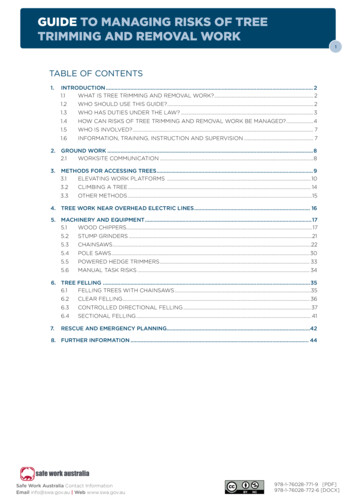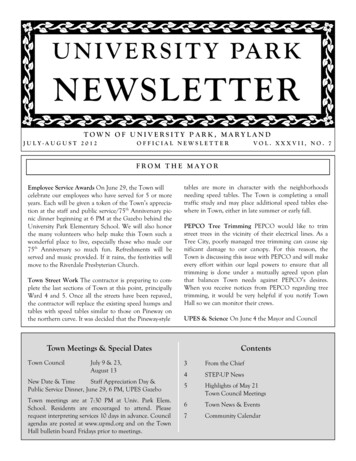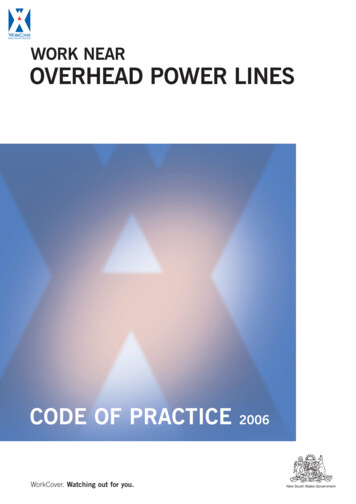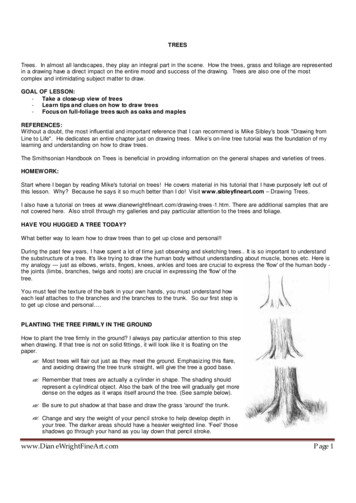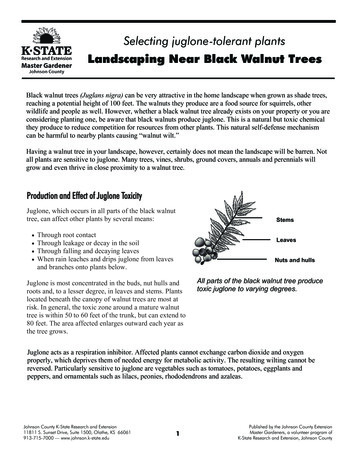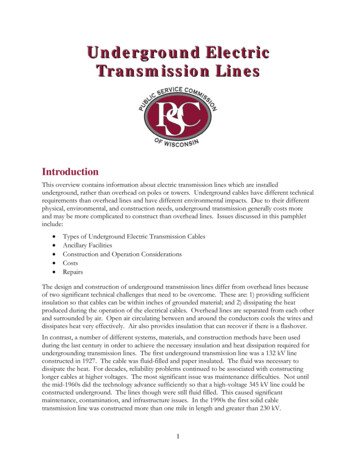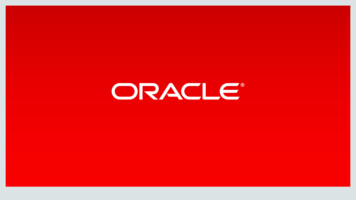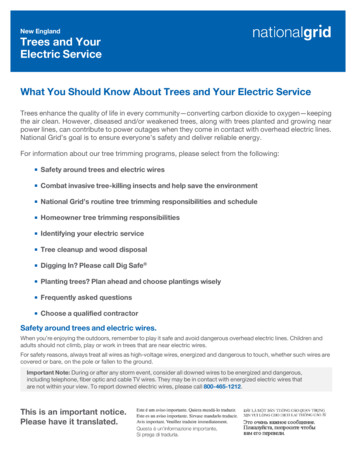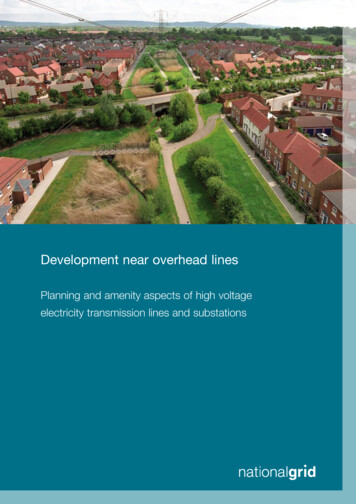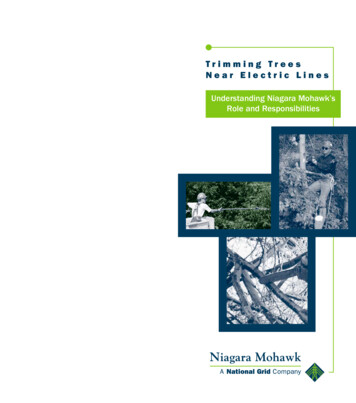
Transcription
Niagara Mohawk, a NationalGrid company, provides electric service to approximately1.5 million customers andnatural gas to approximately540,000 customers in upstateNew York. The company isbased in Syracuse. Its parentcompany also has electricitydistribution operations in NewEngland. National Grid is aninternational, U.K.-basedcompany that builds, owns,and manages electricity andtelecommunication networks.Niagara Mohawk300 Erie Boulevard WestSyracuse, NY 132021-800-NIAGARA (642-4272)www.niagaramohawk.comLit. # 05004/02Copyright 2002. Niagara Mohawk Power CorporationPrintedonRecycled PaperTrimming TreesNear Electric LinesUnderstanding Niagara Mohawk’sRole and Responsibilities
Staying ConnectedIf you’ve called Niagara Mohawk with atree-trimming request, you know we ask a lotof questions. That’s because we need todetermine whether your call may involve anemergency that could affect your electricservice or even cause a safety hazard, orwhether it can be safely handled during ourroutine tree trimming. Your observationshelp us determine how your request ishandled, which makes our questions—andyour answers—very important.We’ve prepared this publication to help youunderstand our tree-trimming practices andhow our Forestry Department works toprotect your Niagara Mohawk electricservice safely and efficiently. Please read thisinformation carefully and use it whenevercalling us about your tree-related questionsand concerns. Our Customer Service number is1-800-NIAGARA (642-4272).When you call Niagara Mohawk and use theterms defined on pages two, three and fourto describe your circumstances, you help ourrepresentatives meet your needs more efficiently. Thank you!121
Determining What's InvolvedChoose a Qualified ContractorHiring a qualified tree-service professional isPrimary W iresimportant to ensuring the safety of yourfamily, home and neighbors. Make sure theWeatherheadSecondary W iresTransformerService Dropcompany or individual you hire is insuredand a member of New York Arborists, theInternational Society of Arboricultureand/or the Utility Arborists Association.CableYour contractor also must have NationalTelephoneMeterArborist Association training for their employeesto educate them in electrical hazards whenworking in proximity to electrical overhead lines.When you call Niagara Mohawk, using thefollowing terms to describe your circumstances can help our representatives meetyour needs more efficiently:UTILITY LINE: Any wire, including electric, cable television or telephoneELECTRIC TRANSFORMER: A gray- orblack-colored, barrel-shaped object mountedon the pole below the primary electric wires.A transformer reduces the primary voltagelevels down to the household voltage levels.ELECTRIC LINE: Any wire carrying electricity through the utility system that runsfrom the electric generation facility to the211
The cleanup of storm debris removed frommeter at your house. Niagara Mohawk cate-on or over Niagara Mohawk facilities, or togorizes its distribution service system intoprovide emergency access, remains thethree types of wires:responsibility of the owner of the tree,whether public or private. Following majorstorms your local municipality often assistsin the cleanup of storm debris.Primary Electric Wire: The electric wiresthat run from pole to pole, usually alongthe street. These wires may run throughbackyards in urban areas or off the roadand across country in rural areas. Wheremore than one utility line (telephone orcable television) is mounted on the samepole, the primary electric wires are at thetop of the pole.Secondary Wire: The electric wires thatrun from pole to pole and are located sixto eight feet below the primary electricwires. They are found below the level ofthe transformer and carry household volt-For Your Protectionage from the transformer to the individualservice lines to your home.Plan Ahead for SafetyYou can help protect your home and community by planting tall-growing trees awayfrom electric lines and right-of-ways. Tallgrowing trees planted beneath or adjacent toelectric lines present a future hazard andeventually will require trimming or removal.Service Drop, Electric Service Line orService Lateral: The electric wires thatrun from the pole to the meter at yourresidence. The most common servicedrop is known as triplex wire. It consistsof a bare center wire with two black,coated wires wrapped around it. OnAsk your local nursery about compatible,older homes, the service drop may below-growing trees that are suitable for plant-three small wires running parallel toing beneath electric lines. For information,each other from the transformer pole orplease call Niagara Mohawk Customersecondary tap to an attachment pointService at 1-800-NIAGARA (642-4272).on your residence.103
INSULATOR: The porcelain support usedto insulate the wires from the pole. All electric lines require an insulator to attach thewires to the pole or to your residence at theweatherhead.WEATHERHEAD: Found on many homes,a weatherhead is a protective metal or plastic service bracket attachment located at thepoint where the line is connected to yourresidence. Any line that attaches to yourweatherhead and/or insulator and meter isan electrical line.When our crews visit your home for treetrimming or removal at your request, youIdentifying Your Electric Servicewill be required to sign an authorizing agree-When it comes to telling electric lines apartment before we can begin work. Once limbsfrom telephone or cable lines, keep the fol-or trees have been safely moved away fromlowing in mind:electric lines, remaining debris cleanup is Primary electric lines are always at ornear the top of the pole. All electric lines are attached at thepole through an insulator. Only electric lines run through atransformer. the responsibility of the property owner.Storm-Damaged TreesA storm can damage just a few trees—or itcan affect thousands across a wide area.Storm damage itself can range from brokenor split limbs to broken or uprooted trees.Niagara Mohawk is responsible for clearingThe line that attaches to your weather-storm-damaged trees from our electric lineshead and meter is an electric line.and facilities in order to:If in doubt about any line, trace the line restore service, allow reasonable access for emergencyfrom the pole back toward your residence.Look for an insulator, transformer or a con-service restoration, ornection to your weatherhead and meter. Ifany of these are present, the line is electric.4 ensure future service reliability.9
Tree Removal RequestsYour Information Is KeyAny time that you are planning to trim orremove trees that are near our primary lines,a Forestry representative will visit your hometo assess the potential for hazard and outagerisk. Please contact us at least five days inadvance of your planned work.To help ensure safe, reliable service for our1.5 million electric customers, the NiagaraMohawk Forestry Department controls treesand vegetation growing near electric facilities. In all, our Forestry crews protect someNiagara Mohawk does not perform complete1.2 million utility poles and more thantree removal for service drops to your house.36,000 miles of electric lines.This work can be done by a qualified contractor who employs tree trimmers specifically trained to work within 10 feet of electricalhazards. Before hiring, ask your contractor toWhile the work of our Forestry crews helpsNiagara Mohawk maintain the highest service reliability, you—as a Niagara Mohawkcustomer—are also essential to that effort.verify that he or she is electrically qualifiedand trains his/her workers to recognize andWhen you call Niagara Mohawk about treessafely work around electrical hazards.or limbs on your property, please give ourrepresentative as much information as possi-Any time you orble. You’ll help us target our response moreyour contractorefficiently and cost effectively—which helpswill be workingus better serve all of our customers.within 10 feet ofany overhead line,When calling us, please be prepared toyou are responsibleanswer these questions:for notifying Niagara MohawkDo you have power? Are your lights dimor flickering?before performing this work. In certain cases involving primary wires, a NiagaraIs a broken tree, branch or limb leaningon or hanging over Niagara Mohawk’sMohawk crew may provide sufficient clear-lines? If so, approximately how long hasance to enable your hired contractor to safe-it been there? How large is the limb (inly complete the job. In some situations thereboth diameter and length)?may be a charge for this work.85
Is the limb or tree on a pole-to-poleline? If so, is it on a primary or second-Policies and Proceduresary electric wire?Tree-Trimming Requests Is the limb or tree on the service linefrom the pole to your meter or weatherhead?Our Forestry Department schedules tree trimming in your area every five to six years, following recognized industry “best practices.” Is a tree arcing or burning in the lines?We will let you know about our routine trim- If an overhead line is involved, is itming—by letter, door hanger or crew visit—owned by Niagara Mohawk? Or does it when work is scheduled on your lines.belong to your telephone or cable televi-If you have a routine tree-trimming requestsion company or other service provider?about the service line to your house, pleaseIs the tree growing into an overhead primary electric line?advise our crew at that time. We will reviewyour request or concern when we have crewsin your neighborhood for routine circuitAs a result of our cyclical tree-trimming pro-trimming. This helps us ensure efficient cus-gram, statistics show that only a small per-tomer service throughout our service area.centage of tree-related outages are the resultof a tree growing into our wires. Most treerelated outages are now caused by a limb,branch or entire tree falling onto the wires.If you have questions about trimming aroundyour house service, please review them withour crews when they are in your neighborhood at the time of your area’s next scheduled tree trimming.Please note: We will dispatch crews toremove larger broken limbs that are pressingon your service lines and to assess trimrequests for trees that have grown into theprimary line.When a property owner denies us the rightto properly trim trees at the time of routinetrimming, the refusal is documented. Wemay ask you to sign a statement acceptingresponsibility for damages related to thereduced trimming.67
Is the limb or tree on a pole-to-poleline? If so, is it on a primary or second-Policies and Proceduresary electric wire?Tree-Trimming Requests Is the limb or tree on the service linefrom the pole to your meter or weatherhead?Our Forestry Department schedules tree trimming in your area every five to six years, following recognized industry “best practices.” Is a tree arcing or burning in the lines?We will let you know about our routine trim- If an overhead line is involved, is itming—by letter, door hanger or crew visit—owned by Niagara Mohawk? Or does it when work is scheduled on your lines.belong to your telephone or cable televi-If you have a routine tree-trimming requestsion company or other service provider?about the service line to your house, pleaseIs the tree growing into an overhead primary electric line?advise our crew at that time. We will reviewyour request or concern when we have crewsin your neighborhood for routine circuitAs a result of our cyclical tree-trimming pro-trimming. This helps us ensure efficient cus-gram, statistics show that only a small per-tomer service throughout our service area.centage of tree-related outages are the resultof a tree growing into our wires. Most treerelated outages are now caused by a limb,branch or entire tree falling onto the wires.If you have questions about trimming aroundyour house service, please review them withour crews when they are in your neighborhood at the time of your area’s next scheduled tree trimming.Please note: We will dispatch crews toremove larger broken limbs that are pressingon your service lines and to assess trimrequests for trees that have grown into theprimary line.When a property owner denies us the rightto properly trim trees at the time of routinetrimming, the refusal is documented. Wemay ask you to sign a statement acceptingresponsibility for damages related to thereduced trimming.67
Tree Removal RequestsYour Information Is KeyAny time that you are planning to trim orremove trees that are near our primary lines,a Forestry representative will visit your hometo assess the potential for hazard and outagerisk. Please contact us at least five days inadvance of your planned work.To help ensure safe, reliable service for our1.5 million electric customers, the NiagaraMohawk Forestry Department controls treesand vegetation growing near electric facilities. In all, our Forestry crews protect someNiagara Mohawk does not perform complete1.2 million utility poles and more thantree removal for service drops to your house.36,000 miles of electric lines.This work can be done by a qualified contractor who employs tree trimmers specifically trained to work within 10 feet of electricalhazards. Before hiring, ask your contractor toWhile the work of our Forestry crews helpsNiagara Mohawk maintain the highest service reliability, you—as a Niagara Mohawkcustomer—are also essential to that effort.verify that he or she is electrically qualifiedand trains his/her workers to recognize andWhen you call Niagara Mohawk about treessafely work around electrical hazards.or limbs on your property, please give ourrepresentative as much information as possi-Any time you orble. You’ll help us target our response moreyour contractorefficiently and cost effectively—which helpswill be workingus better serve all of our customers.within 10 feet ofany overhead line,When calling us, please be prepared toyou are responsibleanswer these questions:for notifying Niagara MohawkDo you have power? Are your lights dimor flickering?before performing this work. In certain cases involving primary wires, a NiagaraIs a broken tree, branch or limb leaningon or hanging over Niagara Mohawk’sMohawk crew may provide sufficient clear-lines? If so, approximately how long hasance to enable your hired contractor to safe-it been there? How large is the limb (inly complete the job. In some situations thereboth diameter and length)?may be a charge for this work.85
INSULATOR: The porcelain support usedto insulate the wires from the pole. All electric lines require an insulator to attach thewires to the pole or to your residence at theweatherhead.WEATHERHEAD: Found on many homes,a weatherhead is a protective metal or plastic service bracket attachment located at thepoint where the line is connected to yourresidence. Any line that attaches to yourweatherhead and/or insulator and meter isan electrical line.When our crews visit your home for treetrimming or removal at your request, youIdentifying Your Electric Servicewill be required to sign an authorizing agree-When it comes to telling electric lines apartment before we can begin work. Once limbsfrom telephone or cable lines, keep the fol-or trees have been safely moved away fromlowing in mind:electric lines, remaining debris cleanup is Primary electric lines are always at ornear the top of the pole. All electric lines are attached at thepole through an insulator. Only electric lines run through atransformer. the responsibility of the property owner.Storm-Damaged TreesA storm can damage just a few trees—or itcan affect thousands across a wide area.Storm damage itself can range from brokenor split limbs to broken or uprooted trees.Niagara Mohawk is responsible for clearingThe line that attaches to your weather-storm-damaged trees from our electric lineshead and meter is an electric line.and facilities in order to:If in doubt about any line, trace the line restore service, allow reasonable access for emergencyfrom the pole back toward your residence.Look for an insulator, transformer or a con-service restoration, ornection to your weatherhead and meter. Ifany of these are present, the line is electric.4 ensure future service reliability.9
The cleanup of storm debris removed frommeter at your house. Niagara Mohawk cate-on or over Niagara Mohawk facilities, or togorizes its distribution service system intoprovide emergency access, remains thethree types of wires:responsibility of the owner of the tree,whether public or private. Following majorstorms your local municipality often assistsin the cleanup of storm debris.Primary Electric Wire: The electric wiresthat run from pole to pole, usually alongthe street. These wires may run throughbackyards in urban areas or off the roadand across country in rural areas. Wheremore than one utility line (telephone orcable television) is mounted on the samepole, the primary electric wires are at thetop of the pole.Secondary Wire: The electric wires thatrun from pole to pole and are located sixto eight feet below the primary electricwires. They are found below the level ofthe transformer and carry household volt-For Your Protectionage from the transformer to the individualservice lines to your home.Plan Ahead for SafetyYou can help protect your home and community by planting tall-growing trees awayfrom electric lines and right-of-ways. Tallgrowing trees planted beneath or adjacent toelectric lines present a future hazard andeventually will require trimming or removal.Service Drop, Electric Service Line orService Lateral: The electric wires thatrun from the pole to the meter at yourresidence. The most common servicedrop is known as triplex wire. It consistsof a bare center wire with two black,coated wires wrapped around it. OnAsk your local nursery about compatible,older homes, the service drop may below-growing trees that are suitable for plant-three small wires running parallel toing beneath electric lines. For information,each other from the transformer pole orplease call Niagara Mohawk Customersecondary tap to an attachment pointService at 1-800-NIAGARA (642-4272).on your residence.103
Determining What's InvolvedChoose a Qualified ContractorHiring a qualified tree-service professional isPrimary W iresimportant to ensuring the safety of yourfamily, home and neighbors. Make sure theWeatherheadSecondary W iresTransformerService Dropcompany or individual you hire is insuredand a member of New York Arborists, theInternational Society of Arboricultureand/or the Utility Arborists Association.CableYour contractor also must have NationalTelephoneMeterArborist Association training for their employeesto educate them in electrical hazards whenworking in proximity to electrical overhead lines.When you call Niagara Mohawk, using thefollowing terms to describe your circumstances can help our representatives meetyour needs more efficiently:UTILITY LINE: Any wire, including electric, cable television or telephoneELECTRIC TRANSFORMER: A gray- orblack-colored, barrel-shaped object mountedon the pole below the primary electric wires.A transformer reduces the primary voltagelevels down to the household voltage levels.ELECTRIC LINE: Any wire carrying electricity through the utility system that runsfrom the electric generation facility to the211
Niagara Mohawk, a NationalGrid company, provides electric service to approximately1.5 million customers andnatural gas to approximately540,000 customers in upstateNew York. The company isbased in Syracuse. Its parentcompany also has electricitydistribution operations in NewEngland. National Grid is aninternational, U.K.-basedcompany that builds, owns,and manages electricity andtelecommunication networks.Niagara Mohawk300 Erie Boulevard WestSyracuse, NY 132021-800-NIAGARA (642-4272)www.niagaramohawk.comLit. # 05004/02Copyright 2002. Niagara Mohawk Power CorporationPrintedonRecycled PaperTrimming TreesNear Electric LinesUnderstanding Niagara Mohawk’sRole and Responsibilities
When our crews visit your home for tree trimming or removal at your request, you will be required to sign an authorizing agree-ment before we can begin work. Once limbs or trees have been safely moved away from electric lines, remaining debris cleanup is the responsibility of the property owner.
